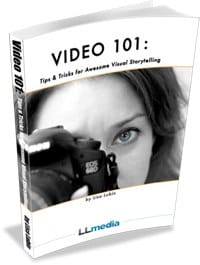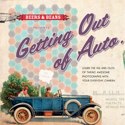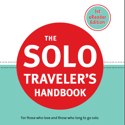
The 43-page book is written mostly for people who need to produce professional-looking videos for their business or website. If you’re just looking to improve the quality of the vacation videos you shoot with your iPhone, or to post short Flip-camera clips of your toddler to YouTube, much of Lubin’s book will seem like overkill to you—you can be forgiven for not being interested in lavalier mics, cutaway shots, written scripts, and the like. But even so, the book may be worth a read; many of its tips are useful for videographers at any level.
The book takes you through the process of creating a video, from deciding the story you want to tell (Lubin offers good advice here about keeping the story small and tightly focused), to shooting the interview(s) and the B-roll footage, to writing and recording the narration, to assembling it all into a cohesive finished piece.
There’s good technical advice on the shooting process, such as “Do not worry about cutting off the top of someone’s head. This is normal in a close-up!” and “Be patient! Good sound bites come. Don’t interrupt the interviewee.” Lubin wisely discourages the overuse of such gimmicks as tilting, panning, and zooming—she advises instead that you turn the camera off, take up a new position, and resume shooting from the new vantage point.
Another smart admonition: “Do NOT narrate while shooting. Nothing says ‘home movie’ more than that.” Instead, record a voiceover later—preferably somewhere quiet. It doesn’t have to be a fancy recording studio, Lubin says: “A nice closet full of clothes can work!”
Lubin’s coverage of the editing process, by contrast, feels a bit more daunting. It assumes that you already know how to use iMovie, Final Cut Pro, or other video-editing software, and that you’re not intimidated by instructions like these:
…if you are starting out with a sound bite, find it, set your in and out points, and edit it into your timeline (include the video too, of course). Then move on to the next thing in your script. Another bite? Narration? A standup? Nat sound break? Find the clip. Mark it. Edit it in.
Lubin does include two stand-alone tear sheets—one listing tips on shooting, the other on editing—as well as a glossary of technical terms.
As Lubin says at the beginning of the book, “Anyone can turn on a camera and press record.” If you need to produce something more pr0fessional, her book may be helpful to you. It’s not a comprehensive tutorial on every aspect of the process, but it’s a very good start.

 Book Review – Air Travel Handbook – Tips, Tricks & Secrets on Flying
Book Review – Air Travel Handbook – Tips, Tricks & Secrets on Flying Book Review – “Getting Out Of Auto” by Bethany Salvon
Book Review – “Getting Out Of Auto” by Bethany Salvon Book Review: “Solo Traveler’s Handbook” by Janice Waugh
Book Review: “Solo Traveler’s Handbook” by Janice Waugh Book Review – “The Expeditioner’s Guide to The World”
Book Review – “The Expeditioner’s Guide to The World”

